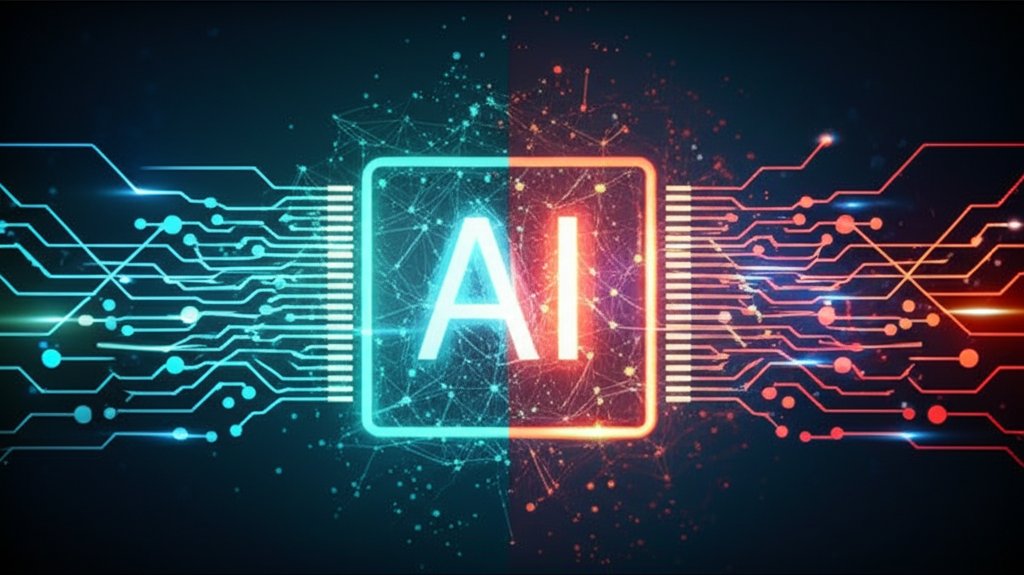In the rapidly evolving digital landscape, it’s easy to assume Artificial Intelligence is the ultimate safeguard for your online security. While AI-powered tools offer incredible speed and efficiency in threat detection, a critical question remains: What if these sophisticated systems are quietly missing crucial vulnerabilities, leaving your personal data or small business exposed? This isn’t a hypothetical scenario; it’s a real and present challenge that demands your attention.
This comprehensive guide dives deep into the often-overlooked blind spots of AI in cybersecurity. We’ll reveal why these advanced tools might fail to detect new, evolving, or cleverly disguised threats, and more importantly, equip you with practical, actionable strategies to strengthen your defenses. Don’t settle for a false sense of security. Take control of your digital resilience now: Discover the hidden vulnerabilities your AI security might miss and learn straightforward steps to protect your small business and personal data.
Table of Contents
- Understanding AI in Cybersecurity: Its Promise and Potential Pitfalls
- AI Security’s Blind Spots: Why Your Tools Can’t Catch Every Cyber Threat
- Zero-Day Attacks Explained: Why Novel Threats Bypass Even Advanced AI
- The “Garbage In, Garbage Out” Problem: How Poor Data Undermines AI Security
- Adversarial AI: Can Cybercriminals Really Trick Your Security Systems?
- Shadow AI Risks: Unapproved Tools and Hidden Vulnerabilities for Your Business
- Inherent Flaws: Are There Vulnerabilities Within AI Security Tools Themselves?
- The Indispensable Human Element: Why AI Needs You for Robust Cybersecurity
- Building Resilience: What is a Hybrid Security Approach and Why You Need It Now
- Empowering Your AI: Practical Steps to Strengthen Your AI-Driven Security Posture
Understanding AI in Cybersecurity: Its Promise and Potential Pitfalls
AI offers incredible promise in cybersecurity, bringing unprecedented speed and scale to threat detection and response. It efficiently processes vast amounts of data, identifying patterns and anomalies that would be impossible for humans to track. For you, this translates to faster identification of malware, phishing attempts, and other malicious activities, theoretically forming a stronger first line of defense.
These systems can analyze network traffic, email content, and user behavior in real-time, flagging anything suspicious. The goal is to reduce manual workloads for security teams (or for you, the individual or small business owner) and provide a more proactive stance against cyber threats. It’s a powerful ally, and frankly, the sheer volume of modern attacks would be unmanageable without it. However, it’s crucial to understand that even this advanced technology is not a silver bullet.
AI Security’s Blind Spots: Why Your Tools Can’t Catch Every Cyber Threat
Your AI security tools cannot catch everything because they primarily learn from past data, making them inherently reactive rather than purely predictive. While incredibly powerful, AI systems have distinct blind spots. They struggle with entirely new threats, flawed or biased training data, and sophisticated attackers who intentionally try to fool them. This limitation means you might be operating with a false sense of comprehensive security, leaving critical gaps in your defenses.
Consider this: AI excels at recognizing what it’s been explicitly taught. If an attack method deviates significantly from its training data, it might classify it as benign or fail to detect it entirely. It’s like a highly skilled detective who only knows about past crimes; a new, never-before-seen criminal might walk right by them unnoticed. These limitations underscore why consistent human oversight and a multi-layered defense strategy are absolutely crucial for truly robust protection.
Zero-Day Attacks Explained: Why Novel Threats Bypass Even Advanced AI
“Zero-day” attacks exploit brand-new software vulnerabilities that developers haven’t even discovered or patched yet, giving them “zero days” to fix it before the attack. AI tools struggle with these because they are trained on patterns of known threats. They lack the historical data necessary to identify something entirely novel. It’s akin to asking an AI to predict next week’s lottery numbers based only on past winning numbers – it doesn’t have the context for something truly unforeseen.
These attacks are particularly dangerous because they bypass traditional signature-based defenses and can even deceive AI that relies on recognizing known malicious behaviors. For you, this presents a significant risk, as your cutting-edge AI might not flag these highly sophisticated and stealthy attacks until it’s too late. To learn more about proactive defense against such threats, explore our article on Zero-Day Vulnerabilities and Business Protection. We need other layers of security, and human vigilance, to counter these elusive threats effectively.
The “Garbage In, Garbage Out” Problem: How Poor Data Undermines AI Security
Bad data significantly cripples your AI security’s effectiveness because AI models are only as good as the information they learn from – it’s the classic “garbage in, garbage out” problem. If the training data is incomplete, biased, old, or contains errors, the AI will make flawed decisions, leading to either missed threats or an excessive number of false alarms. This means your AI might misinterpret benign activity as malicious, causing unnecessary panic, or worse, ignore a real attack because it wasn’t accurately represented in its training.
For individuals and small businesses, this can be a particular challenge. You might not have access to the vast, diverse, and meticulously curated datasets that larger organizations possess. This data quality issue can directly impact the accuracy and reliability of your AI tools, potentially giving you a false sense of security while critical threats slip through the cracks. Ensuring your AI is fed high-quality, relevant, and frequently updated data is paramount to its performance.
Adversarial AI: Can Cybercriminals Really Trick Your Security Systems?
Yes, alarmingly, hackers can and do trick AI through what are known as “adversarial attacks.” These aren’t brute-force hacks but subtle manipulations designed to make AI misinterpret data, causing malicious activities to appear harmless. Imagine changing a few imperceptible pixels on a stop sign so a self-driving car’s AI sees it as a speed limit sign, or tweaking a phishing email just enough so your AI filters think it’s legitimate communication, even though a human would easily spot the fraud.
Cybercriminals are constantly developing new techniques to exploit the predictable ways AI makes decisions. They can add noise to images, inject imperceptible code into files, or slightly alter network traffic patterns to bypass AI detection. This sophisticated cat-and-mouse game highlights that AI, while advanced, isn’t infallible and requires constant vigilance and updates to defend against these clever subversions.
Shadow AI Risks: Unapproved Tools and Hidden Vulnerabilities for Your Business
“Shadow AI” refers to the use of AI tools and services within an organization (or by individuals in a business context) without the IT department’s knowledge, approval, or proper security vetting. It’s akin to employees using unapproved cloud storage – they might be trying to be more productive with new AI writing tools or data analysis platforms, but they inadvertently introduce significant, unmonitored security and compliance risks. Without proper oversight, these unapproved tools can become easy backdoors for attackers.
The danger here is multifold: unapproved AI can process sensitive data in unsecured ways, potentially exposing it in data breaches. It might also have its own inherent vulnerabilities that IT isn’t aware of or managing, creating new entry points for hackers. Furthermore, “Shadow AI” can lead to compliance violations if data is handled outside of regulatory guidelines. It’s a growing problem, emphasizing the critical need for clear guidelines and open communication within any team using AI.
Inherent Flaws: Are There Vulnerabilities Within AI Security Tools Themselves?
Absolutely. AI tools aren’t just susceptible to being tricked; they can also have vulnerabilities inherent in their own design and implementation. Just like any complex software, the code that builds the AI model, the platforms it runs on, or even the way it processes inputs can contain flaws. These “AI-native” vulnerabilities might include insecure ways of handling data, missing input validation (which could allow attackers to inject malicious code), or weaknesses in the underlying algorithms. This represents a critical point often overlooked in general Application Security discussions.
These internal flaws can be exploited by attackers to compromise the AI system itself, leading to data theft, system manipulation, or even using the AI for malicious purposes. For instance, if an AI is used to generate code, and that AI has a flaw, the generated code might inherit security weaknesses. This emphasizes the need for rigorous security testing not just of the data fed into AI, but of the AI models and platforms themselves, to prevent a security tool from becoming a vulnerability.
The Indispensable Human Element: Why AI Needs You for Robust Cybersecurity
Human involvement remains absolutely crucial alongside AI because, despite AI’s capabilities, it lacks true critical thinking, intuition, and the ability to understand context in the nuanced ways humans do. AI is a powerful assistant, but it’s not a replacement for human common sense, skepticism, and the ability to react to truly novel situations. You (or your designated team member) need to understand and review AI-generated alerts, as AI can produce false positives or miss subtle threats that only a human could discern.
Our unique ability to adapt, learn from completely new situations, and apply ethical judgment is irreplaceable. We can spot the social engineering aspects of a phishing attack that an AI might struggle with, or understand the broader business implications of a potential breach. Training yourself and your employees on basic cybersecurity hygiene – like spotting suspicious emails and using strong passwords – empowers the “human element” to be the most vital part of your defense, working in seamless partnership with AI.
Building Resilience: What is a Hybrid Security Approach and Why You Need It Now
A “hybrid” security approach combines the power of AI-driven tools with traditional, proven security measures and, crucially, vigilant human oversight. You need it because no single tool or technology, not even AI, provides complete protection. It’s about building impenetrable layers of defense that make it incredibly difficult for attackers to succeed. This means not putting all your eggs in one AI basket, but rather creating a comprehensive strategy that covers all your bases.
This approach involves using a mix of solutions: robust firewalls to control network traffic, dependable antivirus software, regular data backups, and multi-factor authentication, all working in concert with your AI tools. It also embraces a “Zero Trust” mindset – simplified, this means “never trust, always verify.” Instead of assuming everything inside your network is safe, you continuously verify every user and device trying to access your data. This multi-layered defense creates a formidable barrier that is far more resilient than relying on any single solution alone, safeguarding your critical assets effectively.
Empowering Your AI: Practical Steps to Strengthen Your AI-Driven Security Posture
To make your AI security tools truly effective, start by prioritizing regular updates for all your software, including your operating systems, applications, and especially the AI tools themselves. These updates often contain critical security patches and updated AI models designed to detect the latest threats. Next, ensure your AI is “fed well” by properly configuring your systems to send relevant, clean data and logs to your security tools, as quality input directly improves AI performance and accuracy.
Beyond the tech, practice smart AI adoption: carefully vet any third-party AI tools, thoroughly checking their security track record and privacy policies before integrating them into your operations. For small businesses, establish clear guidelines for AI usage among your team to prevent “Shadow AI” risks. Always encrypt your sensitive data, whether it’s stored on your device or in the cloud, adding a vital layer of protection. Finally, never underestimate the power of human vigilance; continuous user education on cybersecurity best practices is your ultimate safeguard against evolving threats.
Related Questions
- How often should I update my AI security software?
- What’s the best way for a small business to manage its data for AI security?
- Are free AI security tools reliable for business use?
- Can AI help with strong password management?
- What role does encryption play in protecting against AI blind spots?
AI is undoubtedly revolutionizing cybersecurity, offering unprecedented capabilities to detect and neutralize threats. However, it’s crucial to understand that AI isn’t a magical, infallible shield. It has inherent limitations and blind spots that clever attackers actively exploit. A truly robust security posture combines the power of AI with essential human vigilance, diverse security layers, and consistent best practices.
By taking the simple, actionable steps we’ve discussed – like ensuring regular updates, managing your data quality, adopting a hybrid security approach, and empowering your human element – you can significantly reduce your risk. Don’t let a false sense of security leave you vulnerable. Take control of your digital defenses today and build a resilient security strategy that stands strong against tomorrow’s threats.



